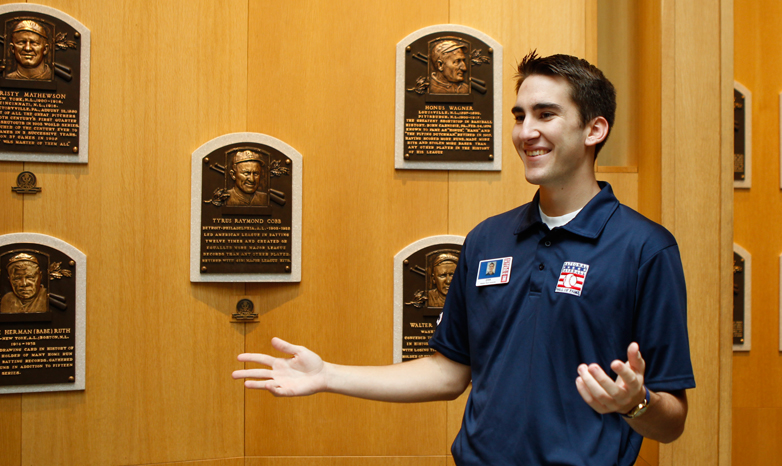SRU education major’s lesson plan scores at Cooperstown

Erik Breit , a secondary education major from Pittsburgh, has authored a lesson plan on Civil Rights and baseball for the National Baseball Hall of Fame and Museum.
Sept. 6, 2016
SLIPPERY ROCK, Pa. - The Civil Rights struggles of African-American baseball players who took the field during the separate and unequal days of the Negro Leagues will soon be understood with greater clarity, especially by children, thanks to a Slippery Rock University secondary education major.
Going deep into the racial history of America's national pastime is Erik Breit, a native of Pittsburgh, who authored a lesson plan on Civil Rights and baseball for the National Baseball Hall of Fame and Museum during his internship with the Hall's education department.
The plan details the disparities between Negro Leagues contracts, transportation, stadiums and players to the then all-white Major League Baseball teams that dominated the game until Jackie Robinson broke the color barrier in 1947 with Brooklyn Dodgers. The Negro Leagues, which included the Pittsburgh Crawfords and renowned pitching sensation Satchel Paige, was launched in the 1880s and spanned nearly seven decades.
"My lesson plan is designed for a little younger audience who might not understand the power they have yet, so teaching Civil Rights to younger students is about teaching them to treat each other with respect," said Breit. "I hope students take away from my lesson that African-Americans were equal to their white MLB counterparts, not only on the field, but also in society. They did not sit back and wait for change, but promoted and fought for change."
Breit said the Hall plans to incorporate a variety of talking points from his plan during school group tours to the institution.
"I know a lesson plan may not sound all that exciting, but creating something for the Baseball Hall of Fame that will be used for the learning and benefit of who knows how many hundreds or thousands of students is pretty awesome," Breit said. "I do not believe many people can put that on their resumes."
Breit said his lesson plan starts with a review of the American Civil War (1861-1865) and the 14th Amendment, which granted citizenship to former slaves. He explains how "African Americans and whites played baseball together following the Civil War" but that blacks were later banned through a "gentleman's agreement" between white team owners.
Breit said he reviewed historic court cases and how they impacted baseball. One example is Plessy v. Ferguson, the 1896 Supreme Court case that upheld state racial segregation laws for public facilities under the doctrine of "separate but equal."
Breit said the court decision led to the acceptance of a separate league for minority players with the season culminating with a "Colored World Series."
He said historians consider the Cuban Giants the game's first black professional team. It formed in 1885 when The Keystone Athletics of Philadelphia, The Orions of Philadelphia and The Manhattans of Washington, D.C., merged. The Negro American League season of 1951 is considered the last all-black season, although The Indianapolis Clowns team operated as an entertainment operation - ala basketball's Harlem Globetrotters - into the 1960s.
In studying Civil Rights and baseball, Breit said he hopes his lesson plan will inspire young people to see that they can make a difference.
"The most important question to ask yourself when creating a lesson plan is, 'why should students learn this?' My answer to that is so students learn about the power they have to make positive change in the world and if you want change, make it happen," he said.
"Everyone is equal and deserves to be treated that way regardless of their background or race. It is important for young students to understand at an early age that everyone is equal, so when they are older and they can see someone not being treated as such, that they will step up and promote equality."
In addition to writing the lesson plan, Breit acted as a tour guide at the Hall and although not a baseball player himself, "knows more baseball facts and about the Hall of Fame than any person would ever need to know." Chief among those facts are that there are currently 312 members of the Hall of Fame; inductee plaques weigh 14.5 pounds and are made it Pittsburgh; and there is one Civil War-era inductee, Morgan Bulkeley. Bulkeley is the only inductee to have enlisted for duty in the Civil War and would go on to serve as the first president of the National League.
The Hall also houses a "Learning Center" with replica baseball equipment, through which Breit led tour groups. "I would teach about the evolution of baseball equipment including balls, bats, gloves, jerseys and catchers equipment and how they evolved over the past 150 years," he said. "I gained great teaching experience and basic public speaking skills because of those programs."
Breit also ran the Hall's Snapchat account during his internship. During his time at the helm of the social media account, more than 1,000 followers joined.
Breit, who plans to become a history teacher, said he met and made friends with people from all over the world, including Canada, Puerto Rico and Australia.
"I was fortunate enough to be selected from a group of more than 500 applicants," said Breit. "The people I met and the things I learned and experienced have already impacted my life."
Now it's time for Breit's lesson plan to do the same.
MEDIA CONTACT: Gordon Ovenshine | 724.738.4854 | gordon.ovenshine@sru.edu

